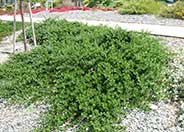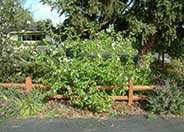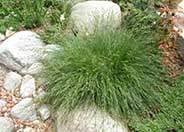
Common name:Yankee Point California Lilac
Botanical name:Ceanothus griseus hor. 'Yankee Point'
Yankee Point is a fast growing shrub that stays near 3' in height with a spread of 6'. It has large, bright green leaves and light blue flowers. It is great for banks and mass plantings. It does well on the coast and in hot inland areas. It attracts hummingbirds, butterflies and beneficial insects.

Common name:Apple, edible
Botanical name:Malus pumila
The common edible apple is a good family edible ornamental tree. Rootstock makes the tree available in: dwarf,semi-dwarf and standard sizes. Select a suitable cultivar for your growing zone. Mild climate, low-chill cv.s are available.

Common name:Creeping Red Fescue
Botanical name:Festuca rubra
Creeping Red Fescue is not red but dark green. It is a great ground cover kept at longer lengths for banks. It is very shade tolerant and lush looking.

Common name:California Meadow Sedge
Botanical name:Carex pansa
This native Carex can be successfully used as a lawn substitute but requires significant water to obtain good coverage. Once coverage is reached, water can be reduced and maintenance is close to zero. Unmowed, the plant can be used effectively in a variety of conditions and will reach a height of 6" or under and spreads up to 2' by rhizomes.
Solving Runoff Problems
Importance of Water Shed
A watershed is a land area that drains rain and other water into a creek, river, lake, wetland, bay or groundwater aquifer. Water from your neighborhood also enters the watershed through the storm drain system and flows directly to local creeks and the Bay without any treatment. It often is contaminated by pollutants that can be toxic to fish, wildlife, and people.Click in the green box for more information
| Designer: | Trail of Grasses |
Photographer: GardenSoft |
Soils and Compost:
Physical weed control, including mulching, or hand removal protects the watershed from harmful chemicals.
Water Saving Tip:
Be sure to fix all leaks promptly no matter how small they may seem.
Integrated Pest Management:
Remove irrigation water and fertilizer from areas where you don't want weeds to grow.
